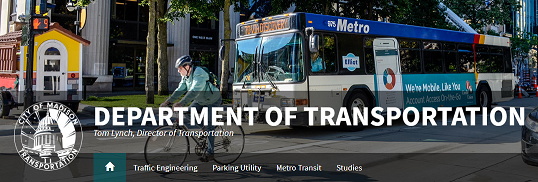Back to the Future With a New DOT
December 25, 2019


Lest this seem overly “wonkish” and of little interest, suffice it to say that one of the major recommendations of the task force on equity in music and entertainment is for a more affordable and expansive bus service and public transit network. For those of us who depend on an affordable transit system to get around, how are we supposed to do anything akin to partaking of music or other entertainment when bus fares are so high and many buses run only once an hour after 6 p.m., even on weekdays? It is necessary for current and would-be bus riders to get involved – wade in the weeds and participate in decision making. Nobody is going to just hand us what we want. The city of Madison established a transportation department (MDOT) separate from “public works” back in 1968. How we get around is a primary function of government – our federal and state governments all have departments of transportation that are multimodal in purview. It is no surprise therefore that MDOT’s supposed existence has stayed on the books since its inception, but its actual existence lapsed after the then-director retired in the early 1990s. Instead, Madison hired a talented young traffic engineer to head a new traffic engineering unit while the heads of the different transportation units found that a “horizontal team approach” toward the management of the transit agency, the parking utility and the traffic engineering units met their needs. In fact, when there was a problem with the management of the Parking Utility some years ago, the head traffic engineer agreed to be the Utility’s titular head as well even as many of the day-to-day issues were actually handled by an assistant parking utility manager. When MDOT was established back in 1968 there seemed little interest in transportation. Everybody was supposedly enamored with the car and the opportunities it provided. Citizen oversight was limited to one Transportation Commission that was supposed to deal with everything. By the 1980s however, it had added a pedestrian/bicycle subcommittee and one of its members also had to be on the Plan Commission. Those modest changes paled in light of what happened after MDOT ceased to exist. For one, the Transportation Commission split into two: a Transit and Parking Commission and a Pedestrian/Bicycle/Motor Vehicle Commission. The Transit and Parking Commission additionally had an ADA Paratransit Oversight Subcommittee and later a Parking Council for People with Disabilities Subcommittee and a Contracted Services Oversight Subcommittee. People also wanted a better connection between land use planning and transportation. Started as a joint subcommittee of the Plan Commission and the Transit and Parking Commission, there developed a Long Range Transportation Planning Committee comprised of members of the Transit and Parking Commission, the Pedestrian/Bicycle Motor Vehicle Commission, the Plan Commission, the Board of Public Works, the county and the regional Transportation Planning Board. Such expansion was a reflection on the need to better integrate different travel modes than was possible with a “horizontal team approach,” the recognition that only one transportationoversight committee was insufficient for dealing with everything, and a need for the integration of different perspectives. But it was over-expansion. By some estimates, there were over 50 seats on transportation-related oversight committees although one person might occupy several seats. People saw the need for another overhaul that would bring Madison back to the idea of one department of transportation that simultaneously oversaw multiple travel modes and was overseen by fewer citizen committees advisory to the Common Council. That overhaul was put in motion by the Common Council Executive Committee. It created an Ad Hoc Transportation Ordinance Review Committee TORC that met for a year and a half starting in March of 2016. The committee reviewed past history and wrestled with whether the department would have a director or a Transportation Policy and Planning Manager, whether there would be two or three main oversight committees, what the membership and functions of those committees would be and how there would be the cross-fertilization of different perspectives on transportation The committee decided to hire an overall director who would staff the “policy and planning” committee effective 6-29-2018, Tom Lynch. Specifics for a department and director are written in legal language as Ordinance 3.14. Madison’s Department of Transportation has two oversight committees: a Transportation Policy and Planning Board (TPPB, Ordinance 33.55) and a Transportation Commission (TC, Ordinance 33.56). The Board deals jointly with issues of land use and transportation. One of its members must be on the Plan Commission. Another member is a “regional representative,” an elected official of a political subdivision that contracts with Metro Transit for transit services. It also has a subcommittee similar to the Contracted Services Oversight Subcommittee of the now defunct Transit and Parking Commission. Membership does not include someone from the more regional Madison Area Transportation Planning Board or the County however. The Transportation Commission deals with all modes of transportation. Instead of monthly meetings of a Transit and Parking Commission on the one hand and a Pedestrian/Bicycle/Motor Vehicle Commission on the other, the Commission is asked to oversee the same amount of material by meeting twice a month. The frequency of Transportation Commission meetings may better integrate the different modes, but it also places a huge burden on fewer committee members. Madison alders often burn out after a few terms because of the heavy workload. Few people can devote so much personal time to really covering the vast amount of material involved. Given ideas about participatory democracy and inclusivity, the new commission structure may be erring in the direction of over-compression whereas the former model erred in the direction of over-expansion. The ideal might be to maximize both integration and inclusivity. After trying the current reorganization for a year, do not be surprised to see changes that try to better balance those values. |